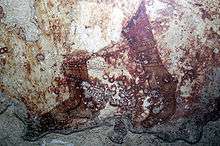Calceus
The Calceus (pl. calcei: cf Latin calx "ankle") was a mid-weight, outdoor walking "shoe-boot", worn in ancient Rome. It was flat-soled, usually hobnailed and entirely covered the foot and ankle, up to the lower shin. It was secured with crossed thongs or laces.[1] Lighter than the openwork caligae favoured by the Roman military, calcei were considered a distinctive part of Rome's public, civilian "national dress", which centered on the toga as an exclusive mark of Roman male citizenship. The calcei of most ordinary citizens were probably a natural brown tanned leather. The equestrian class had its own distinctive form of calceus, with crescent-shaped buckles. Male citizens of senatorial rank and office, including certain priesthoods, were expected to wear a red-bordered toga praetexta and red calcei (s. mulleus calceus) when engaged in their public duties. The combination of toga and calcei was impressive, but also hot and uncomfortable; the Roman poet Martial claims that in their leisure time, and more relaxed surroundings of rural life, hardly anyone used it.[2] Even in the city, some high-ranking citizens wore light, Greek-style sandals, rather than calcei, to "go with the crowd".[3][4]

See also
References
- Goldman, N., in Sebesta, Judith Lynn, and Bonfante, Larissa, editors, The World of Roman Costume: Wisconsin Studies in Classics, The University of Wisconsin Press, 1994, pp. 105-113
- William Smith et al., editors (1890) A Dictionary of Greek and Roman Antiquities, London: William Wayte. G. E. Marindin entry for calceus
- Shumba, L., in Edmondson, J. C., and Keith, A., (Editors), Roman Dress and the Fabrics of Roman Culture, University of Toronto Press, 2008, p. 191
- Edmonson, J. C., in Edmondson, J. C., and Keith, A., (Editors), Roman Dress and the Fabrics of Roman Culture, University of Toronto Press, 2008, pp. 45-47 and note 75